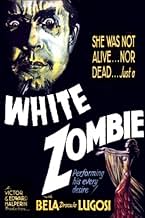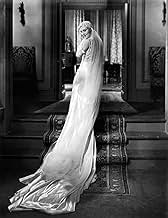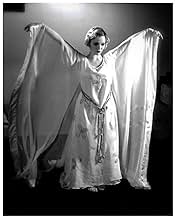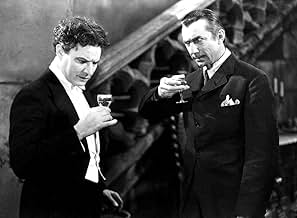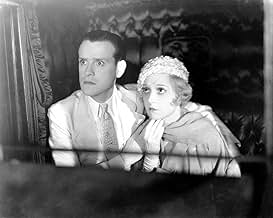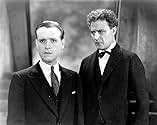A young man turns to a witch doctor to lure the woman he loves away from her fiancé, but instead turns her into a zombie slave.A young man turns to a witch doctor to lure the woman he loves away from her fiancé, but instead turns her into a zombie slave.A young man turns to a witch doctor to lure the woman he loves away from her fiancé, but instead turns her into a zombie slave.
John T. Prince
- Ledot - Zombie
- (as John Printz)
Clarence Muse
- Coach Driver
- (uncredited)
Storyline
Did you know
- TriviaWas a personal favorite of Bela Lugosi, according to his son, Bela Lugosi Jr..
- Goofs(at around 46 mins) The vulture manages to scream, loudly and repeatedly, with its beak shut.
- Quotes
Madeline: Driver, who were those men we saw?
Coach Driver: They are not men, madame. They are dead bodies!
- Crazy credits"White Zombie starring Bela (Dracula) Lugosi."
- Alternate versionsThe scene is which the zombie is crushed by the grinder, after falling into the chute in the factory, is missing from most available prints.
- ConnectionsEdited into Revolt of the Zombies (1936)
- SoundtracksBridal Chorus (Here Comes the Bride)
(uncredited)
from "Lohengrin"
Music by Richard Wagner (1850)
Played on an organ for the wedding
Featured review
A couple of years ago I saw the 1931 version of Dracula as part of a live performance for the new musical score composed by Philip Glass. Even in this refined setting, the film was met by laughter from the audience during several sections. This seemed rather odd to me, but I suppose older horror films cannot help but lose some of their initial impact over time. The black and white photography and performance techniques became antiquated, hence humorous to some. As time went on, filmmakers begin to spoof the broad overacting and dramatic music of the vintage horror picture. It is impossible today to view a film like WHITE ZOMBIE and fully understand the impact it may have had in 1932. It does, however, escape (for the most part anyway) the mirthful reactions described above.
Director Victor Halprin's telling of this tale is often cited as the genesis of the "zombie picture." There is some debate about this, but WHITE ZOMBIE is certainly one of the early films to deal with the Haitian legend of "the dead that walk." The story revolves around a young couple who have traveled through Haiti to meet with their friend and benefactor Charles Beaumont (Robert Frazer), at whose villa they plan to be married. He has designs on the young bride, Madeleine (Madge Bellamy), and enlists the help of Murder Legendre (the name kind of says it all) played by Bela Lugosi. After the wedding, Legendre performs some "witchcraft" rituals and Madeleine falls into a death-like state. Believing that she has in fact died, the newly minted groom (John Harron) spirals into a drunken maelstrom, eventually seeking out the learned missionary Dr. Bruner (Joseph Cawthorn) to help solve the mystery. All paths seem to lead back to Legendre as the plot thickens and Beaumont's true motives are discovered.
It is fascinating to watch these type of films, some of which, like WHITE ZOMBIE age well with time. This is partly due to the fact that it has been largely forgotten in the wake of the more successful Universal horror flicks. The main drawn here will be the performance by Lugosi. He essentially "vamps" his role in Dracula, but manages to fashion a fairly distinct and unsettling screen presence. It would be roles like this however that would lead to his rigid typecasting; as time went on, he was all but discarded by the film industry (see ED WOOD [1994] for his later years). Halprin's direction focuses on atmosphere and gloom. He is well paired with cinematographer Arthur Martinelli and together they create a suitably shadow-laden backdrop for this macabre story. WHITE ZOMBIE is ambitious in camera angles and editing. At one point there is a diagonal wipe edit, which stops midscreen to reveal the actions of two separate characters. This type of effect is effortless to achieve now, but must have been laborious in 1932. Observe also the unusually large transitional set of the plantation interior, or the framing of Lugosi though the ornate stone work during certain shots. These small details help set WHITE ZOMBIE apart by creating a realistic environment and aid in visually representing the pathology of the characters.
Since the 30's there has been countless movies about killer zombies run amuck. The concept predominantly became fodder for B-grade schlock productions. The genre would experience something of a renaissance in 1968 with George Romero's NIGHT OF THE LIVING DEAD which created quite a stir at the time and resulted in zombies becoming, once again, fashionable. The Haitian setting of WHITE ZOMBIE would also be revisited in THE SERPENT AND THE RAINBOW (1988) and the "undead" as a means of cheap labor subtext would be exploited for darkly comedic effect in the underrated HBO film CAST A DEADLY SPELL (1991). In recent years, there has been such a boom of these "living dead" productions that it is hard to keep track of them all. WHITE ZOMBIE, as an early example of this current trend, but should be seen as more than just a footnote in the ever growing history of film. It is not a great movie, like Dracula, but will prove to be of interest to film buffs at least. It has more to offer, though, and I hope that it will continue to be rediscovered by successive generations. 7/10
Director Victor Halprin's telling of this tale is often cited as the genesis of the "zombie picture." There is some debate about this, but WHITE ZOMBIE is certainly one of the early films to deal with the Haitian legend of "the dead that walk." The story revolves around a young couple who have traveled through Haiti to meet with their friend and benefactor Charles Beaumont (Robert Frazer), at whose villa they plan to be married. He has designs on the young bride, Madeleine (Madge Bellamy), and enlists the help of Murder Legendre (the name kind of says it all) played by Bela Lugosi. After the wedding, Legendre performs some "witchcraft" rituals and Madeleine falls into a death-like state. Believing that she has in fact died, the newly minted groom (John Harron) spirals into a drunken maelstrom, eventually seeking out the learned missionary Dr. Bruner (Joseph Cawthorn) to help solve the mystery. All paths seem to lead back to Legendre as the plot thickens and Beaumont's true motives are discovered.
It is fascinating to watch these type of films, some of which, like WHITE ZOMBIE age well with time. This is partly due to the fact that it has been largely forgotten in the wake of the more successful Universal horror flicks. The main drawn here will be the performance by Lugosi. He essentially "vamps" his role in Dracula, but manages to fashion a fairly distinct and unsettling screen presence. It would be roles like this however that would lead to his rigid typecasting; as time went on, he was all but discarded by the film industry (see ED WOOD [1994] for his later years). Halprin's direction focuses on atmosphere and gloom. He is well paired with cinematographer Arthur Martinelli and together they create a suitably shadow-laden backdrop for this macabre story. WHITE ZOMBIE is ambitious in camera angles and editing. At one point there is a diagonal wipe edit, which stops midscreen to reveal the actions of two separate characters. This type of effect is effortless to achieve now, but must have been laborious in 1932. Observe also the unusually large transitional set of the plantation interior, or the framing of Lugosi though the ornate stone work during certain shots. These small details help set WHITE ZOMBIE apart by creating a realistic environment and aid in visually representing the pathology of the characters.
Since the 30's there has been countless movies about killer zombies run amuck. The concept predominantly became fodder for B-grade schlock productions. The genre would experience something of a renaissance in 1968 with George Romero's NIGHT OF THE LIVING DEAD which created quite a stir at the time and resulted in zombies becoming, once again, fashionable. The Haitian setting of WHITE ZOMBIE would also be revisited in THE SERPENT AND THE RAINBOW (1988) and the "undead" as a means of cheap labor subtext would be exploited for darkly comedic effect in the underrated HBO film CAST A DEADLY SPELL (1991). In recent years, there has been such a boom of these "living dead" productions that it is hard to keep track of them all. WHITE ZOMBIE, as an early example of this current trend, but should be seen as more than just a footnote in the ever growing history of film. It is not a great movie, like Dracula, but will prove to be of interest to film buffs at least. It has more to offer, though, and I hope that it will continue to be rediscovered by successive generations. 7/10
- underfire35
- Jul 30, 2005
- Permalink
- How long is White Zombie?Powered by Alexa
Details
- Release date
- Country of origin
- Language
- Also known as
- Zombi - Yaşayan Ölüler
- Filming locations
- Production company
- See more company credits at IMDbPro
Box office
- Budget
- $50,000 (estimated)
- Runtime1 hour 9 minutes
- Color
- Aspect ratio
- 1.37 : 1
Contribute to this page
Suggest an edit or add missing content




